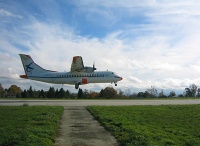If you wish to contribute or participate in the discussions about articles you are invited to contact the Editor
EGNOS Safety of Life Service
| EGNOS | |
|---|---|
| Title | EGNOS Safety of Life Service |
| Author(s) | GMV |
| Level | Basic |
| Year of Publication | 2011 |
The EGNOS Safety of Life Service (SoL) consists of an augmentation signal to the Global Positioning System (GPS) Standard Positioning Service (SPS) intended for most transport safety critical applications. The target application domains are, thus, aviation, maritime, railway and road where degradation in the navigation system performance without a notice within the specified time to alert would endanger lives.
Terms and Conditions
The Safety of Life Service is accessible to any user equipped with an EGNOS certified receiver and located within the appropriate EGNOS SoL Service area.
However, navigation operations based on the EGNOS SoL Service require authorization issued by the relevant authority unless the specific authority or applicable regulation states that no such authorization is required. This authorization, as defined in EGNOS Mission Requirements Document[1], is subject to specified operational conditions and limitations, existence of published navigation procedure and to the certification of the on board navigation equipment.
Consequently, an aircraft or operator will need to be subscriber of the required Service Level Agreement in order to get a service guarantee from the EGNOS Service Provider on the EGNOS Safety of Life Service. In addition, the service guarantee will only be applicable within the Safety of Life Service area.
EGNOS SoL for Aviation
The SoL Service is intended to support a wide range of transport domains. Nevertheless, the main objective of the EGNOS SoL service is to support civil aviation operations down to Localizer Performance with Vertical guidance (LPV). This means that the service is compliant with aviation Approach with Vertical Guidance (APV-I) requirements defined in the International Civil Aviation Organization (ICAO)[2] Standard and Recommended Practices (SARPs) for SBAS[3] as expressed in EGNOS Safety of Life Service Definition Document.[4]
At the the time of the edition of this article, only the aviation domain has specific service requirements, as well as certification and individual authorization procedures developed and implemented.
On the 2nd March 2011, the European Satellite Services Provider (ESSP)[5] declared[6] the Safety-of-Life (SoL) signal officially available for aviation with the authorization of the European Commission (EC) to provide the service. At this point message type 0 (MT0) that used to transmit the same contents as a regular MT2 message before certification of EGNOS for civil aviation was removed.
The aviation user, as mentioned in the Terms and Conditions definition, is subject to the specific Working Agreements between ESSP and Air Navigation Service Providers (ANSPs) as stated by the EC Single European Sky regulation.[7]
In this context, the EGNOS SoL Service is only guaranteed for use in aviation, for all phases of flight within the corresponding EGNOS SoL Service area, to aviation users. Aviation users, as referred in the EGNOS SoL Service Definition Document,[4] are namely:
- Airspace users, as defined in the Single European Sky framework Regulation,[8] equipped with an EGNOS certified receiver and located within the appropriate EGNOS SoL Service area corresponding to the phase of flight in which the EGNOS SoL Service is used.
- Certified Air Navigation Service Providers having signed a working agreement with ESSP SAS that is valid at the moment of the use of the EGNOS SoL Service.
The EGNOS SoL Service will be provided for a minimum period of 20 years and any significant change in the service will be notified at least six years in advance.'
Safety of Life Requirements
A summary of Safety of Life service performance requirements for civil aviation is provided in the following table where requirements for Non Precision and Precision Approaches have been issued by ICAO. EGNOS Mission Requirements Document[1] establishes its performances in line with these requirements.
| Typical Operation | Horizontal Accuracy (95%) | Vertical Accuracy (95%) | Integrity | Time-To-Alert (TTA) | Horizontal Alert Limit (HAL) | Vertical Alert Limit (HAL) | Continuity | Availability |
|---|---|---|---|---|---|---|---|---|
| Initial Intermediate Nonprecision approaches & Departure | 220 m (720 ft) | N/A | 1 –1x10-7/h | 10 s | 556 m (0.3 NM) | N/A | 1 – 1x10-4/h to 1 – 1x10-8/h | 0.99 to 0.99999 |
| Approach operations with vertical guidance (APV-I) | 16.0 m (52 ft) | 20 m (66 ft) | 1 – 2x10-7 (per approach) | 10 s | 40 m (130 ft) | 50 m (164 ft) | 1 – 8x10-6/15s | 0.99 to 0.99999 |
Benefits for Civil Aviation
The EGNOS Safety of Life service was declared operational for use in aviation upon completion of a certification process against applicable Safety of Life standards and requirements. In particular for civil aviation, Single European Sky regulations were applied.
This declaration enables precision approaches and renders air navigation safer. In the same way, this accessible Service contributes to reducing delays, diversions and cancellations of flights while the airport capacities are increased and operating costs reduced.
Some of the most remarkable advantages provided by the EGNOS Safety of Life service were enumerated in the EGNOS Safety of Life press release published in the European Commission EGNOS homepage:[9]
- Increased aviation safety: EGNOS allows to perform precision approaches which reduce safety risks considerably.
- Lower operating costs: EGNOS signals are freely accessible and only requires a receiver aboard the aircraft with no necessity of ground infrastructure.
- Lower CO2 emissions: EGNOS permits more efficient definition of flight routes.
- Less delays, diversions and cancellations: EGNOS allows lower aircraft separation distances which results in fewer delays, diversions and cancellations of flights.
- Less noise pollution: EGNOS facilitates optimized flight routes and 'curved approach' procedures allowing planes to commence their descent closer to the runway.
- Increased capacity for smaller airports: The vertical guidance offered by EGNOS means planes are able to land in restricted visibility conditions, increasing the capacity of airports.
Notes
References
- ^ a b EGNOS Mission Requirements Document, version 2.0, 8th May 2006, Galileo Joint Undertaking
- ^ ICAO Annex10 Volume I (Radio Navigation Aids) – 6th Edition – July 2006 amendment 85
- ^ Minimum Operational Performance Standards for Global Positioning System/Wide Area Augmentation System Airbone Equipment
- ^ a b EGNOS Safety of Life Service Definition Document
- ^ European Satellite Services Provider
- ^ ESSP press release EGNOS Safety-of-Life Service starting on March the 2nd
- ^ Regulation (EC) No 549/2004 of the European Parliament and of the Council of 10 March 2004 laying down the framework for the creation of the single European sky
- ^ Regulation (EC) No 549/2004 of the European Parliament and of the Council of 10th March 2004 laying down the framework for the creation of the single European sky (the framework Regulation).
- ^ European Commission EGNOS homepage




